*NURSING > QUESTIONS & ANSWERS > SOLVED!!! NR 509 COMPREHENSIVE REVIEW OF JARVIS 7TH EDITION CHAPTER 3 QUESTIONS (The Interview: Phys (All)
SOLVED!!! NR 509 COMPREHENSIVE REVIEW OF JARVIS 7TH EDITION CHAPTER 3 QUESTIONS (The Interview: Physical Examination & Health Assessment)
Document Content and Description Below
SOLVED!!! NR 509 COMPREHENSIVE REVIEW OF JARVIS 7TH EDITION CHAPTER 3 QUESTIONS (The Interview: Physical Examination & Health Assessment) ◇This material contains comprehensive summary of information... in the form of great test questions with descriptive answers helpful for exams study. Thorough Review of Jarvis 7th Edition Chapter 3 Questions. All the best Champions!!! _____ MULTIPLE CHOICE 1. The nurse is conducting an interview with a woman who has recently learned that she is pregnant and who has come to the clinic today to begin prenatal care. The woman states that she and her husband are excited about the pregnancy but have a few questions. She looks nervously at her hands during the interview and sighs loudly. Considering the concept of communication, which statement does the nurse know to be most accurate? The woman is: a. Excited about her pregnancy but nervous about the labor. b. Exhibiting verbal and nonverbal behaviors that do not match. c. Excited about her pregnancy, but her husband is not and this is upsetting to her. d. Not excited about her pregnancy but believes the nurse will negatively respond to her if she states this. ANS: B Communication is all behaviors, conscious and unconscious, verbal and nonverbal. All behaviors have meaning. Her behavior does not imply that she is nervous about labor, upset by her husband, or worried about the nurse’s response. DIF: Cognitive Level: Analyzing (Analysis) MSC: Client Needs: Psychosocial Integrity REF: p. 28 2. Receiving is a part of the communication process. Which receiver is most likely to misinterpret a message sent by a health care professional? a. Well-adjusted adolescent who came in for a sports physical b. Recovering alcoholic who came in for a basic physical examination c. Man whose wife has just been diagnosed with lung cancer d. Man with a hearing impairment who uses sign language to communicate and who has an interpreter with him ANS: C The receiver attaches meaning determined by his or her experiences, culture, self-concept, and current physical and emotional states. The man whose wife has just been diagnosed with lung cancer may be experiencing emotions that affect his receiving. DIF: Cognitive Level: Analyzing (Analysis) MSC: Client Needs: Psychosocial Integrity REF: p. 28 3. The nurse makes which adjustment in the physical environment to promote the success of an interview? a. Reduces noise by turning off televisions and radios b. Reduces the distance between the interviewer and the patient to 2 feet or less Providesd. Arranges seating across a desk or table to allow the patient some personal space ANS: A The nurse should reduce noise by turning off the television, radio, and other unnecessary equipment, because multiple stimuli are confusing. The interviewer and patient should be approximately 4 to 5 feet apart; the room should be well-lit, enabling the interviewer and patient to see each other clearly. Having a table or desk in between the two people creates the idea of a barrier; equal-status seating, at eye level, is better. DIF: Cognitive Level: Applying (Application) MSC: Client Needs: Psychosocial Integrity REF: p. 29 4. In an interview, the nurse may find it necessary to take notes to aid his or her memory later. Which statement is true regarding note-taking? a. b. c. d. Note-taking may impede the nurse’s observation of the patient’s nonverbal behaviors. Note-taking allows the patient to continue at his or her own pace as the nurse records what is said. Note-taking allows the nurse to shift attention away from the patient, resulting in an increased comfort level. Note-taking allows the nurse to break eye contact with the patient, which may increase his or her level of comfort. ANS: A The use of history forms and note-taking may be unavoidable. However, the nurse must be aware that note-taking during the interview has disadvantages. It breaks eye contact too often and shifts the attention away from the patient, which diminishes his or her sense of importance. Note-taking may also interrupt the patient’s narrative flow, and it impedes the observation of the patient’s nonverbal behavior. DIF: Cognitive Level: Understanding (Comprehension) MSC: Client Needs: Psychosocial Integrity REF: p. 30 5. The nurse asks, “I would like to ask you some questions about your health and your usual daily activities so that we can better plan your stay here.” This question is found at the __________ phase of the interview process. Summary a. b. c. Closing Body d. Opening or introduction ANS: D When gathering a complete history, the nurse should give the reason for the interview during the opening or introduction phase of the interview, not during or at the end of the interview. DIF: Cognitive Level: Understanding (Comprehension) REF: p. 31MSC: Client Needs: Psychosocial Integrity 6. A woman has just entered the emergency department after being battered by her husband. The nurse needs to get some information from her to begin treatment. What is the best choice for an opening phase of the interview with this patient? “Hello, Nancy, my name is Mrs. C.” a. b. c. d. “Hello, Mrs. H., my name is Mrs. C. It sure is cold today!” “Mrs. H., my name is Mrs. C. How are you?” “Mrs. H., my name is Mrs. C. I’ll need to ask you a few questions about what happened.” ANS: D Address the person by using his or her surname. The nurse should introduce him or herself and give the reason for the interview. Friendly small talk is not needed to build rapport. DIF: Cognitive Level: Applying (Application) MSC: Client Needs: Psychosocial Integrity REF: p. 31 7. During an interview, the nurse states, “You mentioned having shortness of breath. Tell me more about that.” Which verbal skill is used with this statement? a. Reflection b. Facilitation c. Direct question d. Open-ended question ANS: D The open-ended question asks for narrative information. It states the topic to be discussed but only in general terms. The nurse should use it to begin the interview, to introduce a new section of questions, and whenever the person introduces a new topic. DIF: Cognitive Level: Understanding (Comprehension) MSC: Client Needs: Psychosocial Integrity REF: p. 31 8. A patient has finished giving the nurse information about the reason he is seeking care. When reviewing the data, the nurse finds that some information about past hospitalizations is missing. At this point, which statement by the nurse would be most appropriate to gather these data? a. b. c. d. “Mr. Y., at your age, surely you have been hospitalized before!” “Mr. Y., I just need permission to get your medical records from County Medical.” “Mr. Y., you mentioned that you have been hospitalized on several occasions. Would you tell me more about that?” “Mr. Y., I just need to get some additional information about your past hospitalizations. When was the last time you were admitted for chest pain?” ANS: DThe nurse should use direct questions after the person’s opening narrative to fill in any details he or she left out. The nurse also should use direct questions when specific facts are needed, such as when asking about past health problems or during the review of systems. DIF: Cognitive Level: Applying (Application) MSC: Client Needs: Psychosocial Integrity REF: p. 31 9. In using verbal responses to assist the patient’s narrative, some responses focus on the patient’s frame of reference and some focus on the health care provider’s perspective. An example of a verbal response that focuses on the health care provider’s perspective would be: a. Empathy. b. Reflection. Facilitation. c. d. Confrontation. ANS: D When the health care provider uses the response of confrontation, the frame of reference shifts from the patient’s perspective to the perspective of the health care provider, and the health care provider starts to express his or her own thoughts and feelings. Empathy, reflection, and facilitation responses focus on the patient’s frame of reference. DIF: Cognitive Level: Remembering (Knowledge) MSC: Client Needs: Psychosocial Integrity REF: p. 32 10. When taking a history from a newly admitted patient, the nurse notices that he often pauses and expectantly looks at the nurse. What would be the nurse’s best response to this behavior? Be silent, and allow him to continue when he is ready. a. b. c. d. Smile at him and say, “Don’t worry about all of this. I’m sure we can find out why you’re having these pains.” Lean back in the chair and ask, “You are looking at me kind of funny; there isn’t anything wrong, is there?” Stand up and say, “I can see that this interview is uncomfortable for you. We can continue it another time.” ANS: A Silent attentiveness communicates that the person has time to think and to organize what he or she wishes to say without an interruption from the nurse. Health professionals most often interrupt this thinking silence. The other responses are not conducive to ideal communication. DIF: Cognitive Level: Applying (Application) MSC: Client Needs: Psychosocial Integrity REF: p. 33 11. A woman is discussing the problems she is having with her 2-year-old son. She says, “He won’t go to sleep at night, and during the day he has several fits. I get so upset when that happens.” The nurse’s best verbal response would be: “Go on, I’m listening.” a.b. c. d. “Fits? Tell me what you mean by this.” “Yes, it can be upsetting when a child has a fit.” “Don’t be upset when he has a fit; every 2 year old has fits.” ANS: B The nurse should use clarification when the person’s word choice is ambiguous or confusing (e.g., “Tell me what you mean by fits.”). Clarification is also used to summarize the person’s words or to simplify the words to make them clearer; the nurse should then ask if he or she is on the right track. DIF: Cognitive Level: Applying (Application) MSC: Client Needs: Psychosocial Integrity REF: p. 33 12. A 17-year-old single mother is describing how difficult it is to raise a 3-year-old child by herself. During the course of the interview she states, “I can’t believe my boyfriend left me to do this by myself! What a terrible thing to do to me!” Which of these responses by the nurse uses empathy? a. b. c. d. “You feel alone.” “You can’t believe he left you alone?” “It must be so hard to face this all alone.” “I would be angry, too; raising a child alone is no picnic.” ANS: C An empathetic response recognizes the feeling and puts it into words. It names the feeling, allows its expression, and strengthens rapport. Other empathetic responses are, “This must be very hard for you,” “I understand,” or simply placing your hand on the person’s arm. Simply reflecting the person’s words or agreeing with the person is not an empathetic response. DIF: Cognitive Level: Applying (Application) MSC: Client Needs: Psychosocial Integrity REF: p. 28 13. A man has been admitted to the observation unit for observation after being treated for a large cut on his forehead. As the nurse works through the interview, one of the standard questions has to do with alcohol, tobacco, and drug use. When the nurse asks him about tobacco use, he states, “I quit smoking after my wife died 7 years ago.” However, the nurse notices an open pack of cigarettes in his shirt pocket. Using confrontation, the nurse could say: “Mr. K., I know that you are lying.” a. b. c. d. “Mr. K., come on, tell me how much you smoke.” “Mr. K., I didn’t realize your wife had died. It must be difficult for you at this time. Please tell me more about that.” “Mr. K., you have said that you don’t smoke, but I see that you have an open pack of cigarettes in your pocket.” ANS: DIn the case of confrontation, a certain action, feeling, or statement has been observed, and the nurse now focuses the patient’s attention on it. The nurse should give honest feedback about what is seen or felt. Confrontation may focus on a discrepancy, or the nurse may confront the patient when parts of the story are inconsistent. The other statements are not appropriate. DIF: Cognitive Level: Applying (Application) MSC: Client Needs: Psychosocial Integrity REF: p. 33 14. The nurse has used interpretation regarding a patient’s statement or actions. After using this technique, it would be best for the nurse to: a. Apologize, because using interpretation can be demeaning for the patient. b. Allow time for the patient to confirm or correct the inference. Continue with the interview as though nothing has happened. c. d. Immediately restate the nurse’s conclusion on the basis of the patient’s nonverbal response. ANS: B Interpretation is not based on direct observation as is confrontation, but it is based on one’s inference or conclusion. The nurse risks making the wrong inference. If this is the case, then the patient will correct it. However, even if the inference is correct, interpretation helps prompt further discussion of the topic. DIF: Cognitive Level: Analyzing (Analysis) MSC: Client Needs: Psychosocial Integrity REF: p. 33 15. During an interview, a woman says, “I have decided that I can no longer allow my children to live with their father’s violence, but I just can’t seem to leave him.” Using interpretation, the nurse’s best response would be: “You are going to leave him?” a. b. c. d. “If you are afraid for your children, then why can’t you leave?” “It sounds as if you might be afraid of how your husband will respond.” “It sounds as though you have made your decision. I think it is a good one.” ANS: C This statement is not based on one’s inference or conclusion. It links events, makes associations, or implies cause. Interpretation also ascribes feelings and helps the person understand his or her own feelings in relation to the verbal message. The other statements do not reflect interpretation. DIF: Cognitive Level: Applying (Application) MSC: Client Needs: Psychosocial Integrity REF: p. 3316. A pregnant woman states, “I just know labor will be so painful that I won’t be able to stand it. I know it sounds awful, but I really dread going into labor.” The nurse responds by stating, “Oh, don’t worry about labor so much. I have been through it, and although it is painful, many good medications are available to decrease the pain.” Which statement is true regarding this response? The nurse’s reply was a: a. b. c. d. Therapeutic response. By sharing something personal, the nurse gives hope to this woman. Nontherapeutic response. By providing false reassurance, the nurse actually cut off further discussion of the woman’s fears. Therapeutic response. By providing information about the medications available, the nurse is giving information to the woman. Nontherapeutic response. The nurse is essentially giving the message to the woman that labor cannot be tolerated without medication. ANS: B By providing false assurance or reassurance, this courage builder relieves the woman’s anxiety and gives the nurse the false sense of having provided comfort. However, for the woman, providing false assurance or reassurance actually closes off communication, trivializes her anxiety, and effectively denies any further talk of it. DIF: Cognitive Level: Analyzing (Analysis) MSC: Client Needs: Psychosocial Integrity REF: p. 32 17. During a visit to the clinic, a patient states, “The doctor just told me he thought I ought to stop smoking. He doesn’t understand how hard I’ve tried. I just don’t know the best way to do it. What should I do?” The nurse’s most appropriate response in this case would be: “I’d quit if I were you. The doctor really knows what he is talking about.” a. b. c. d. “Would you like some information about the different ways a person can quit smoking?” “Stopping your dependence on cigarettes can be very difficult. I understand how you feel.” “Why are you confused? Didn’t the doctor give you the information about the smoking cessation program we offer?” ANS: B Clarification should be used when the person’s word choice is ambiguous or confusing. Clarification is also used to summarize the person’s words or to simplify the words to make them clearer; the nurse should then ask if he or she is on the right track. The other responses give unwanted advice or do not offer a helpful response. DIF: Cognitive Level: Applying (Application) MSC: Client Needs: Psychosocial Integrity REF: p. 3318. As the nurse enters a patient’s room, the nurse finds her crying. The patient states that she has just found out that the lump in her breast is cancer and says, “I’m so afraid of, um, you know.” The nurse’s most therapeutic response would be to say in a gentle manner: “You’re afraid you might lose your breast?” a. b. c. d. “No, I’m not sure what you are talking about.” “I’ll wait here until you get yourself under control, and then we can talk.” “I can see that you are very upset. Perhaps we should discuss this later.” ANS: A Reflection echoes the patient’s words, repeating part of what the person has just said. Reflection can also help express the feelings behind a person’s words. DIF: Cognitive Level: Applying (Application) MSC: Client Needs: Psychosocial Integrity REF: p. 33 19. A nurse is taking complete health histories on all of the patients attending a wellness workshop. On the history form, one of the written questions asks, “You don’t smoke, drink, or take drugs, do you?” This question is an example of: a. Talking too much. b. Using confrontation. c. Using biased or leading questions. d. Using blunt language to deal with distasteful topics. ANS: C This question is an example of using leading or biased questions. Asking, “You don’t smoke, do you?” implies that one answer is better than another. If the person wants to please someone, then he or she is either forced to answer in a way that corresponds to his or her implied values or is made to feel guilty when admitting the other answer. DIF: Cognitive Level: Understanding (Comprehension) MSC: Client Needs: Psychosocial Integrity REF: p. 34 20. When observing a patient’s verbal and nonverbal communication, the nurse notices a discrepancy. Which statement is true regarding this situation? The nurse should: a. Ask someone who knows the patient well to help interpret this discrepancy. b. Focus on the patient’s verbal message, and try to ignore the nonverbal behaviors. c. d. Try to integrate the verbal and nonverbal messages and then interpret them as an average. Focus on the patient’s nonverbal behaviors, because these are often more reflective of a patient’s true feelings. ANS: D When nonverbal and verbal messages are congruent, the verbal message is reinforced. When they are incongruent, the nonverbal message tends to be the true one because it is under less conscious control. Thus studying the nonverbal messages of the patients and examiners and understanding their meanings are important. The other statements are not true. [Show More]
Last updated: 1 year ago
Preview 1 out of 16 pages
.png)
Buy this document to get the full access instantly
Instant Download Access after purchase
Add to cartInstant download
We Accept:

Reviews( 0 )
$15.00
Document information
Connected school, study & course
About the document
Uploaded On
Sep 13, 2021
Number of pages
16
Written in
Additional information
This document has been written for:
Uploaded
Sep 13, 2021
Downloads
0
Views
48

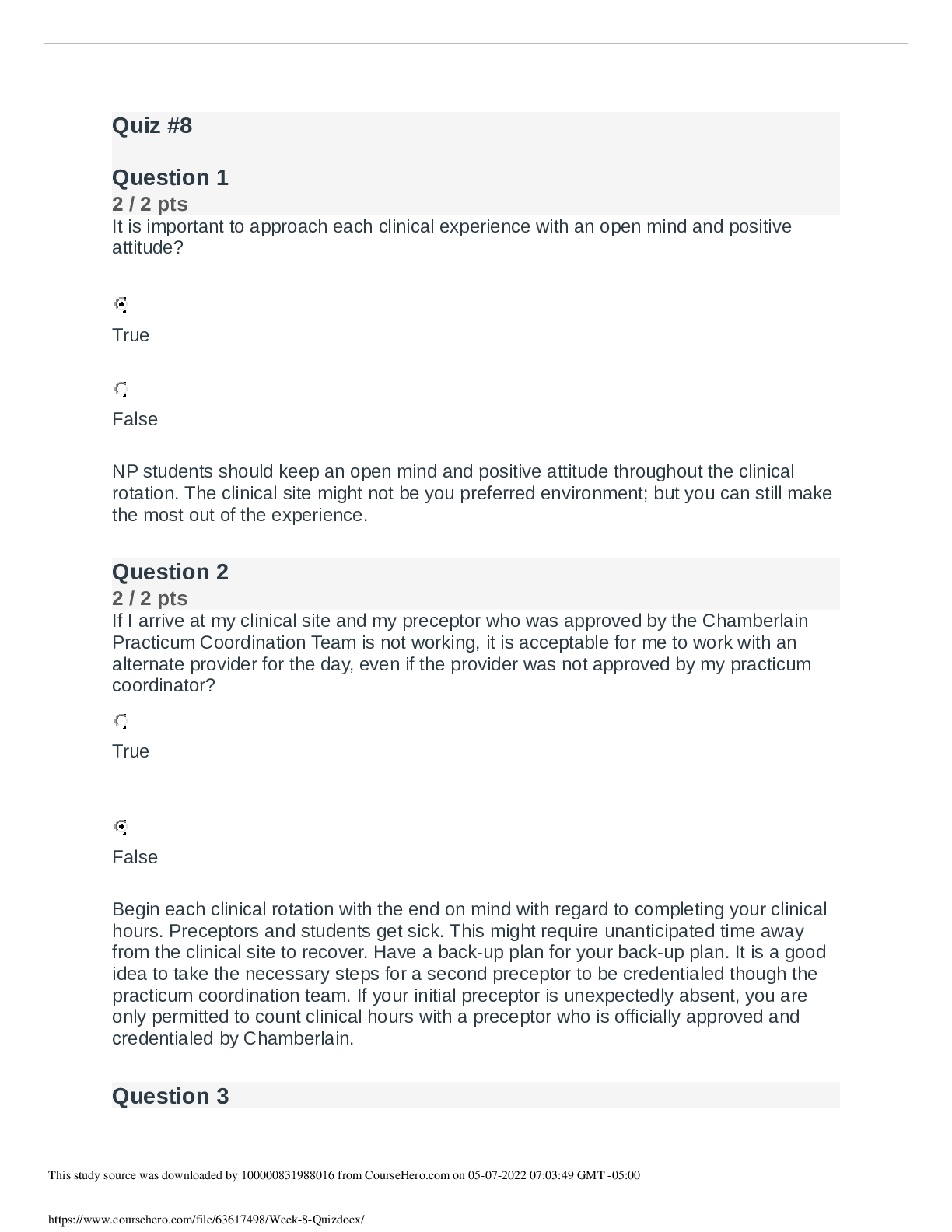



.png)
.png)
.png)

.png)

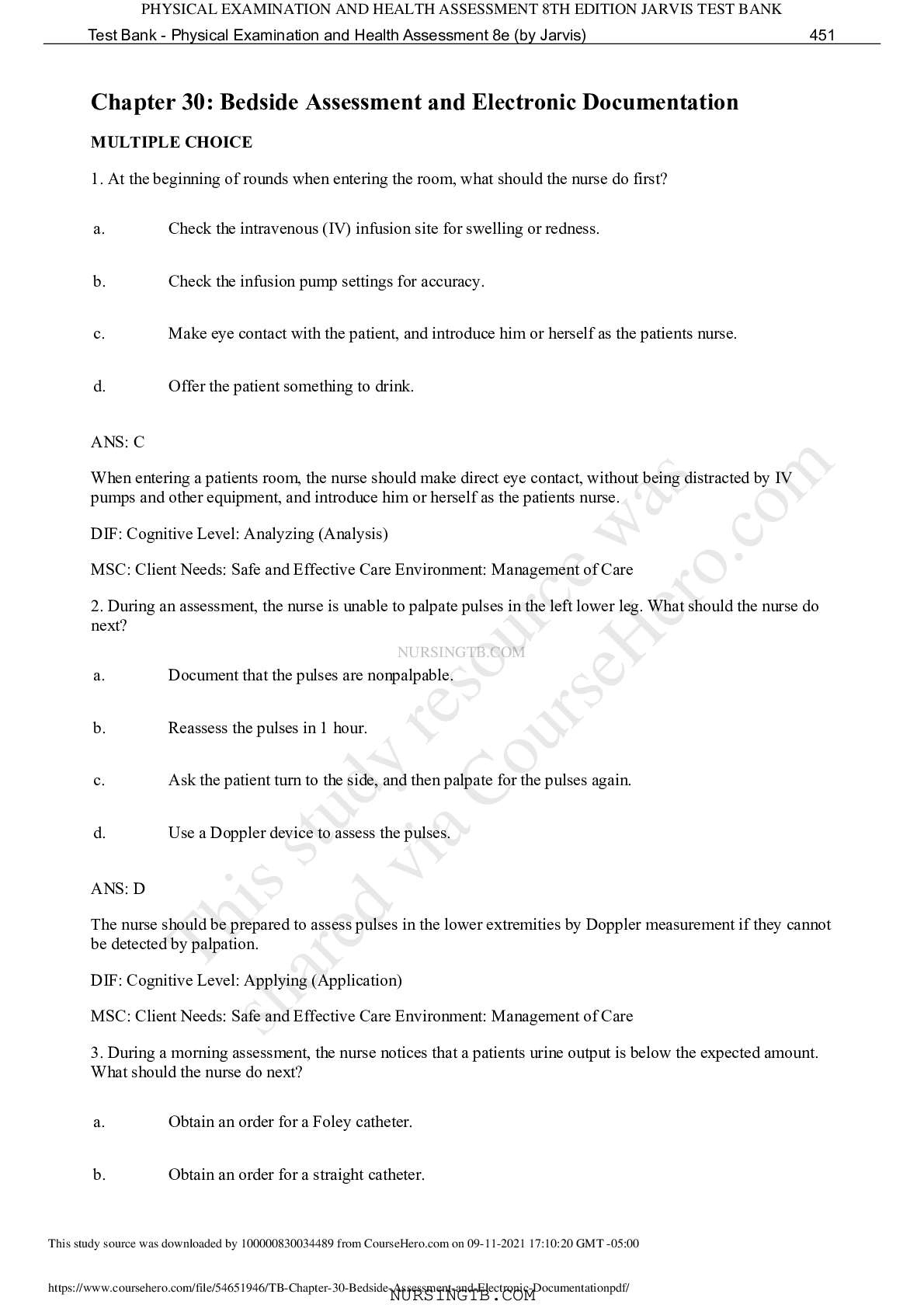

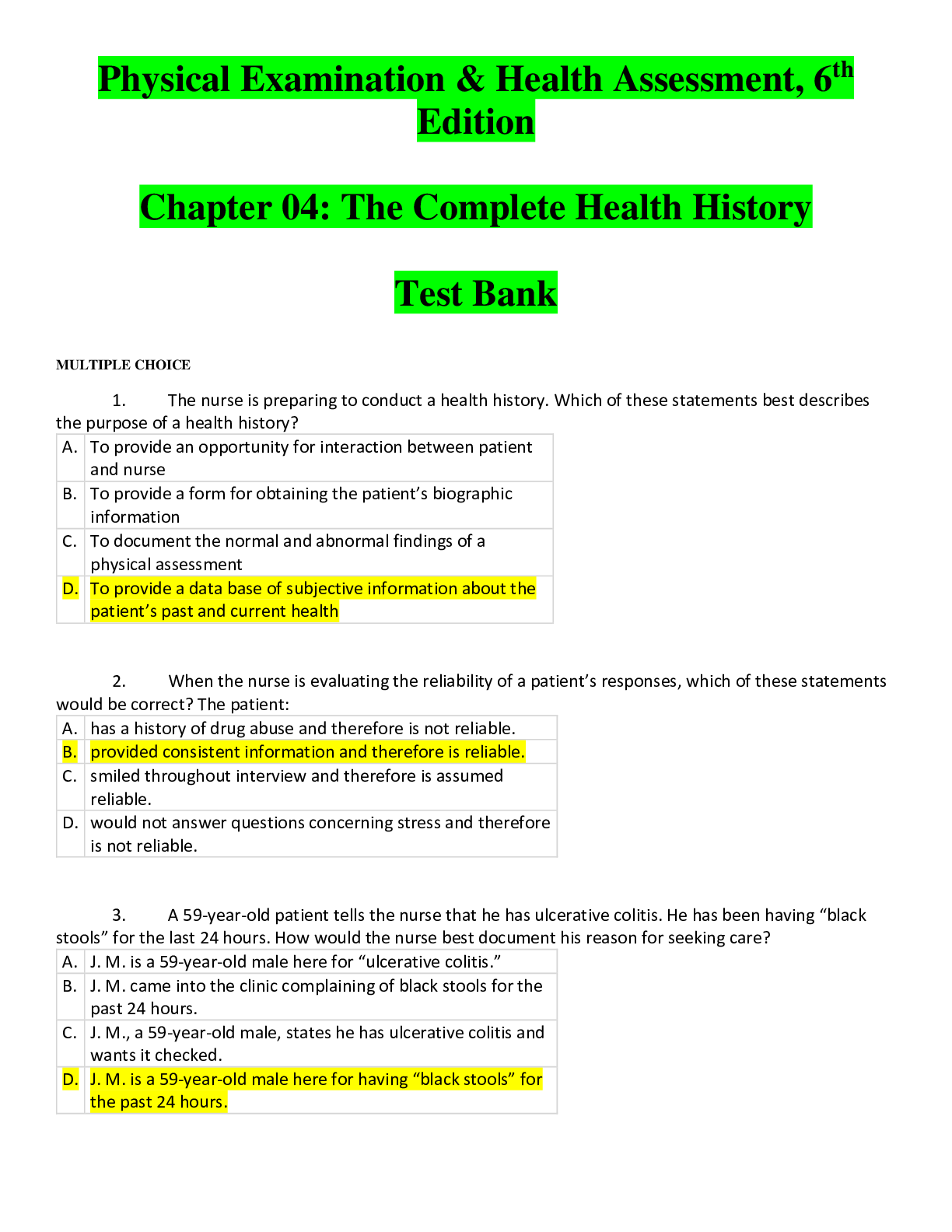
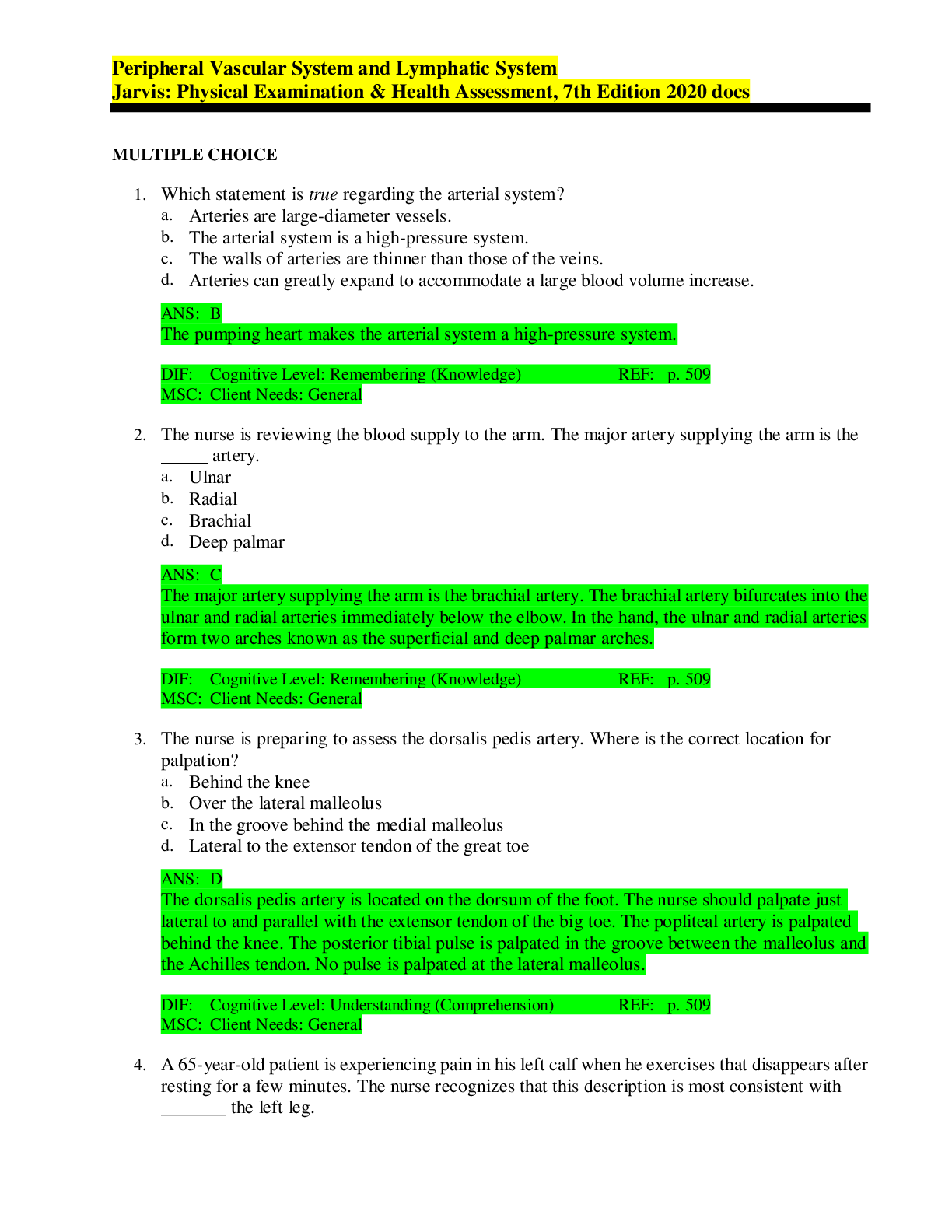
 answers.png)
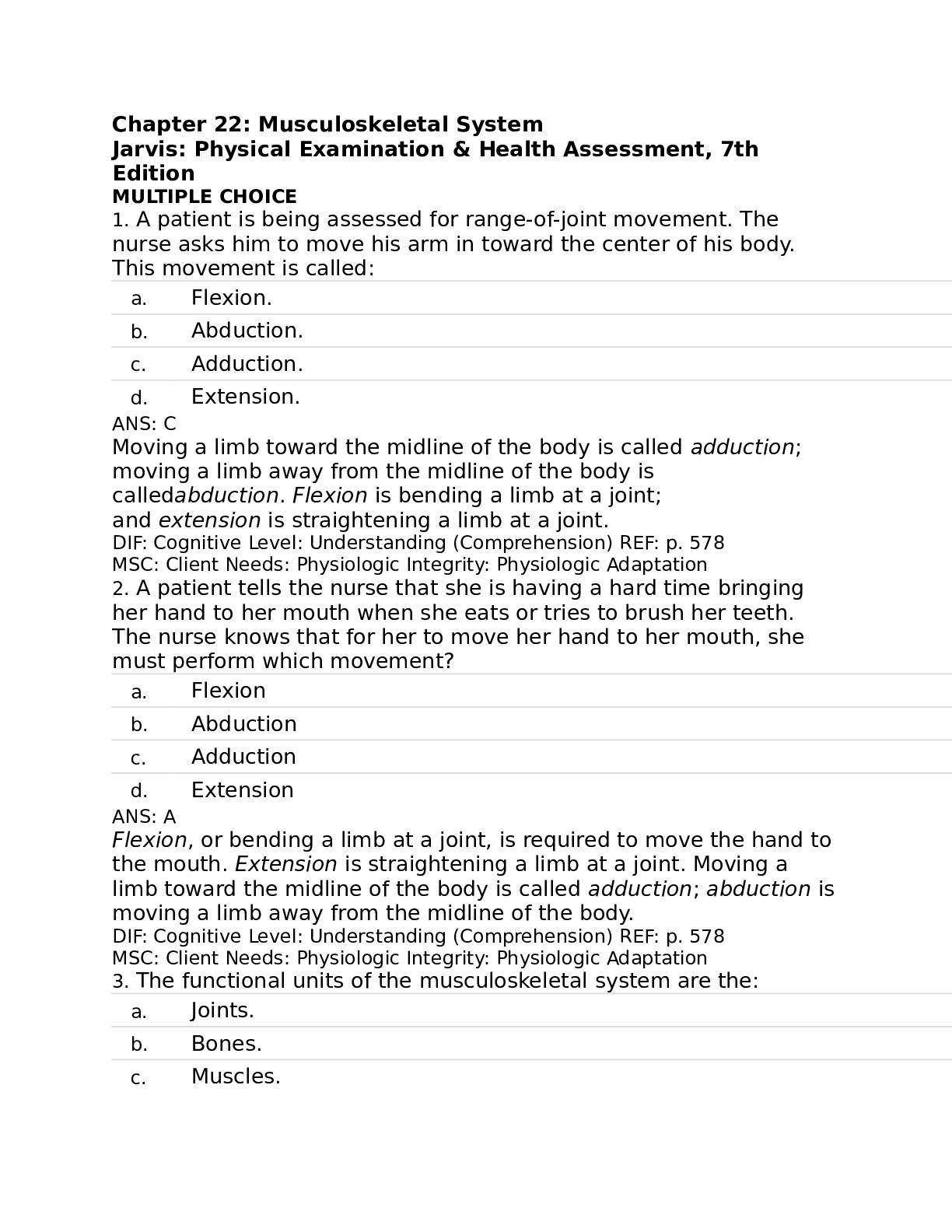
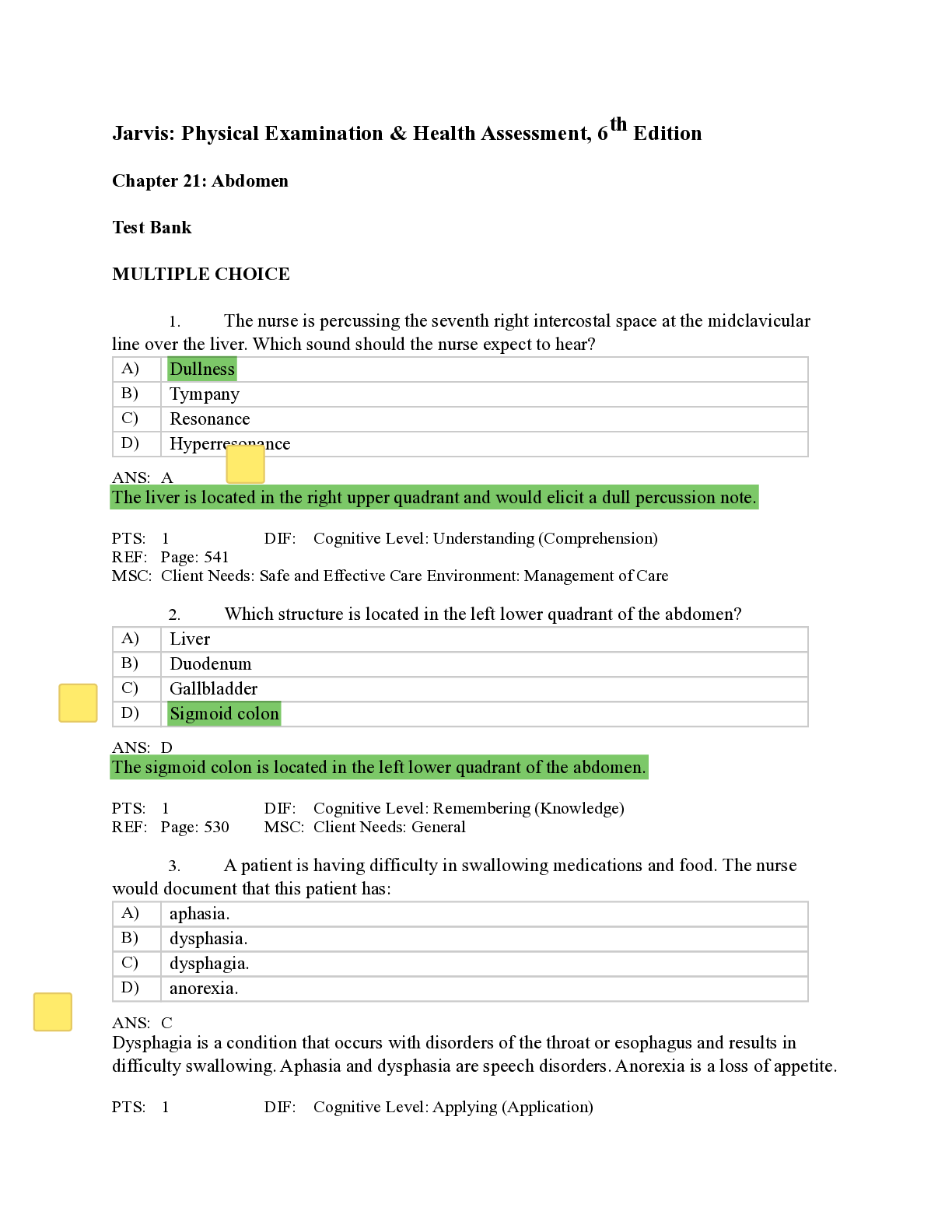
, Latest Questions and Answers with Explanations for Revision, All C.png)
, Latest Questions and Answers with Explanations for Revision, All Correct Latest Review, (La.png)
, Latest Questions and Answers with Explanations for Revision, All Correct Latest Review, (Latest 2021) Correc.png)
, Latest Questions and Answers with Explanations for Revision, All Correct Latest Revie.png)

